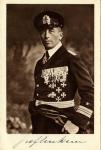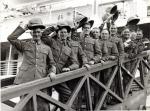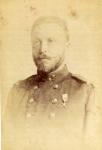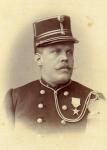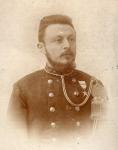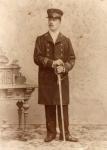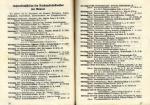-
Posts
2,143 -
Joined
-
Last visited
-
Days Won
10
Content Type
Profiles
Forums
Blogs
Gallery
Events
Store
Everything posted by Odulf
-

British Bugle
Odulf replied to jonsey2001's topic in Great Britain: Militaria: Badges, Uniforms & Equipment
Agree Mervyn, this xxxx has flooded the market some decades ago, and will run around for a century or more! I wonder how many ignorant collectors throw good money at bad collectables like these? -
Thanks Morten, This topic started as one for Kriegsmarine tallies, but as it is it's camel nosing into a general German tally thing. The tallies for ships are easy to define, because the ships' data are easy to find. But there are many more tallies of (land or sea based) units or shore establishments, and some of these were shortly functional. These are very interesting, also because there is (to my knowledge) no complete catalogue of Kriegsmarine cap tallies. Against that back ground, photos showing the tallies of units are most interesting as evidence.
-

boer war pith helmet ?
Odulf replied to blueman's topic in Great Britain: Militaria: Badges, Uniforms & Equipment
A clear press photo from my collection, showing this type of "Wolsey" helmet being worn in 1937. The text on the back reads: Battalion arrivés home after 17 1/2 years of foreign service. After seventeen-and-a-half years of continuous foreign service, the 2nd Battalion The Essex Regiment arrived home at Southampton. While abroad, they served in Malta, Turkey, India, Egypt and the Sudan. They were also present at "emergencies" in Constantinopel in 1920 and 1921, North West Frontier of India in 1930-1931 and the Western Desert (Egypt) 1935-1936. PHOTO SHOWS: - Three officers and none men of the Battalion, who have served the whole 17 1/2 years abroad, coming ashore on their arrival at Southampton. W February 20th 1937 PN.r. -
No.1 is probably Korvettenkapitän a.D. Ernst Hintzmann, the President (Bundesführer) of the NS Deutscher Marine-Bund, wearing the uniform of the NSDMB. The monument was erected due to the effords of his organisation. Away from the camera, is this Korvettenkapitän in a Kriegsmarine uniform. He sports an amazing chest of medals and decorations (in 2 rows!) and could be recognized for that reason. Does any one have an idea?
-

Identification on what looks like ... handcuffs....?
Odulf replied to Stuka f's topic in Non Military Collectibles & Antiques
When the material is leather (not showing to well) it looks like restraining instruments from a medical facility, 19th century. The notch may yet indicate some medical or physical purpose (to put pressure on a sinew or vessel). Let's not assume they were for slaves, those collars and irons were produced much cheaper. Also I lack the ring(s) to lock in the bearer; what are diametres? -

Great Britain Royal Signals Cap
Odulf replied to Markgraf's topic in Great Britain: Militaria: Badges, Uniforms & Equipment
According to Brian L. Davis' British Army Uniforms & Insignia of Worl War Two (p.274), this number was assigned to Royal Artillery (reaching from 721,001 / 1,942,000. R.Sigs. numbered 2,303,001 / 2,604,000 -

British Medal bar, incomplete
Odulf replied to JensF.'s topic in Great Britain: Orders, Gallantry, Campaign Medals
Hmm, could be anything, but likely a Long Service Medal of Efficiency Medal. As these are named, it will be a hell of a job to reunite it with the rest of the group... -
i think you're right, Salzwedel. I have one also, though more in close-up, and the "F" is right above the nose, on other Unterseebootsflottille tallies, the "F" is more to the left or to the right (depending on the total lenght of the tekst). Also, the first Capital of the last word looks like a "S".
-
Nice find Robin, but these crosses have been produced until the 1950s. The skull was nothing more than a Memento Mori. When I was young, I saw these, and many other shapes, sizes and materials, being sold in the verger's shop, with chains of beats large enough to tow a small battleship. From the early 14th century, when there were no Rosaries yet, the custom of prayer-chains developed. These had two ends and were not tied in a circle. The origine of these rosaries (as they developed to be later lies in the Crusades, when Christian soldiers noticed the Islamic prayer-chains with 33 beads). So to stipulate the vanity and mortality, one, or in some very severe cases, both ends of the chain were decorated with a skull in bone, silver, clay or any other material matching the purse of the buyer. The skull remained a very strong symbol in Catholisism, up to the recent past. Clerics are free to buy their crosses where ever they want, and as such, there is no official Army Pattern Chaplains Cross in any army (at least not to my knowledge), there were commercial religious products of bakelite, tin, plastics and other cheap materials, sold in stores to soldies and sailors, but these were by no means "official". So for eBayers, I can advice not to take the big words as "official" of "issue" serious; I am not... Also, the age of these arte-facts are generaly over rated, The big boom of this simple, mechanicaly produced stuff dates after 1875, when cheap nickle-alloys were available, copper framed crosses may be older, but the finish of the corpus is important; cast and not moulded... With so many Catholics in Europe this stuff is as rare as whale manure on the bottem of the ocean (no disrespect to you, nor to your find, Robin!)
-

Great Britain Group of British WWII medals
Odulf replied to Asjemenou's topic in Great Britain: Orders, Gallantry, Campaign Medals
This is a group of medals open for conversation for many months and more... It is not since so long that these, unattributed, groups are fetching higher prizes because they are getting fewer. In the past dealers bought these 2nd WW groups for pennies, broke them up and sold the individual stars and medals for a few bob, after seperating the bravery, meritorious and long service medals first and Air Crew Europe Star also; because the market (i.c. collectors) was not interested in run of the mill stars and medals.... This has always been a game of fast money making, and I have seen bags full of similar stars change hands for little money. Primeraly, this was up to the veteran or his descendants - disposing his medals for whatever reasons, next the medals landed with a (kind hearted) dealer who had to make a living but wanting to pay coin, and now, after 70 years these simple groups (without named bravery and long service medals) are getting a bit of respect. I guess, that's how it goes.... An unnamed (Naval) group of let's say China (1857-60), Crimea, and Turkish Crimea will fetch some money today (when on the original broach...) or otherwise a fair market prize, but half a century and a bit more ago, these were sold for little more than scarp silver. Bronze and nickle medals were the cheapest Britain could offer in the 40s, and men who wanted to name their medals, could have that done privately (at Boots, for instance); but the vast majority did not bother.... They had to get their life together and carry on. I feel that we have to know and respect the circumstances of 2nd WW veterans, today the living last of these, are celebrated as heroes and liberators on the continent, in their service years they were Private Nobody, and after the war they were happy to earn a simpel living. That is how the wheel of fortune and respect turns. We have seen the prizes of Pip, Squeek and Wilfred rise when the records became available (and many groups are still missing Squeek because he was sold for silver), but the 2nd WW medals were run down by the bucket for next to nothing. Alas there are no statistics, but I would respect any group of insignificant medals with suspicion first, but also with respect when I find reasons to believe it might be genuine -

Great Britain Group of British WWII medals
Odulf replied to Asjemenou's topic in Great Britain: Orders, Gallantry, Campaign Medals
The medals were sent to recipient in a small brown cardboard box, with the medals and ribbons loose, and a slip of paper about which ribbon to match with the stars/medals. For conscrips and war time volunteers who left the Forces in or shortly after 1945 and who probably never wore their medals there was no issue about mounting them correctly. -
A strange German postcard.... The photo shows the portrait of a Belgian trooper of the 1st Rgt. Guides (Gidsen), but on his field cap he wears an English brass shoulder title of the Royal Garrison Artillery.... This card was sent by a Vizefeldwebel of the Landst.Inf.Ers.Btl. Landau II B13, 4.Kp on 01-05-1916 I can't help wondering why a German editor would print and sell postcards with portraits of Belgian soldiers....
-
It indicates that he was a very well decorated man, his Orders and Decorations were: Prussian Order of the Red Eagle 3rd class with bow and 4th class with crown. Prussian Crown Order 2nd class Prussian Long Service Decoration German Iron Cross 2nd and 1st class Bayarian Military Merit Order 2nd class with swords Oldenburg Friedrich August Cross 1st class Royal Saxon Order of Albrecht, Commander 2nd class with swords Order of the Crown of Wurttemberg, Commander with swords Danish Dannebrog Order, Commander 2nd grade Greek Order of the Redeemer, Knight of the Gold Cross Royal Italian Order of the Crown, Commander Dutch Order of Orange-Nassau, Commander Norwegian Order of St.Olav, Commander 2nd class Russia, Order of St.Anne, 2nd class Sweden, Order of the Sword, Knight 1st class Spain, Order of Merit, 3rd class Turkey, Osmania Order, 3rd class He was placed on the reserve list in 1919. His promotions were thus honorary.



